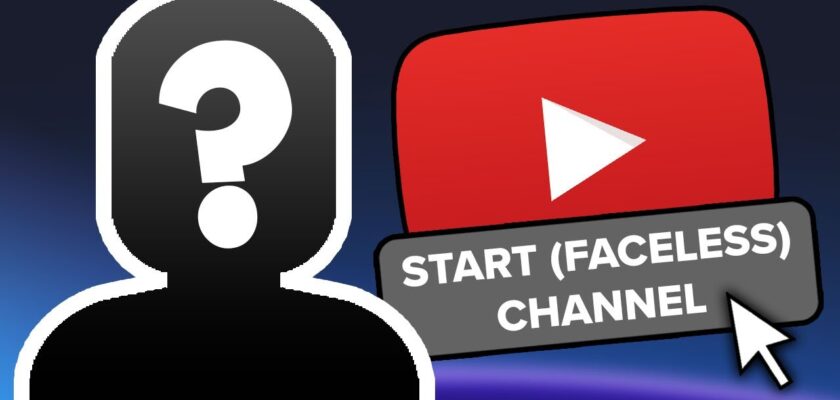Starting a faceless YouTube channel can be a great way to maintain your privacy while still creating content and engaging with an audience. Here are the steps to help you get started:
A faceless YouTube channel is a YouTube channel where the creator does not show their face on camera or reveal their real name. Instead, they may use a pseudonym or remain completely anonymous. There are many reasons why someone might choose to create a faceless YouTube channel. Some people may be camera shy, while others may want to protect their privacy. Still others may simply prefer to focus on the content of their videos rather than their own appearance.
There are many different types of faceless YouTube channels. Some popular niches include:
- Tutorials: This could include anything from how-to videos on cooking or makeup to software tutorials or educational content.
- Reviews: This could include product reviews, book reviews, or movie reviews.
- Vlogs: This could be a personal vlog about your life or a more focused vlog on a specific topic, such as travel or fashion.
- Animations: This could be anything from stop-motion animation to 2D or 3D animation.
- Podcasts: This could be a solo podcast or a podcast with guests.
No matter what type of faceless YouTube channel you choose to create, there are a few things you’ll need to keep in mind:
- The quality of your content is still important: Even if you’re not showing your face, your videos should still be well-produced and engaging.
- Be creative with your visuals: You’ll need to find creative ways to tell your story without using your face. This could involve using stock footage, animation, or even just text overlays.
- Be patient: It takes time to build an audience on YouTube, even if you’re not showing your face. Don’t get discouraged if you don’t see results overnight.
If you’re interested in starting a faceless YouTube channel, I encourage you to go for it! There are many possibilities, and you can create a successful channel no matter what your niche is.
Define your niche for make YouTube Channel

Decide on the theme or topic of your channel. Choose something you are passionate about and have expertise in. This will help you create content that resonates with your audience. How I define niche for my faceless AI generated YouTube channel.
- Interest and Passion
- AI Content Generation Capabilities
- Audience Demand
- Analyze the competition in your selected niches.
- Assess the availability of AI tools and technologies for the niche you’re interested in. Some niches may have more readily available AI solutions for content generation than others.
- Ensure that AI-generated content meets a certain quality standard. Poorly generated content can deter viewers, so make sure the AI tools you use are reliable and produce high-quality results.
Plan your content.
Outline your video ideas and create a content schedule. Consistency is key on YouTube, so try to stick to a regular uploading schedule that works for you.
The success of your YouTube channel will depend on your dedication, consistency, and the value you provide to your audience.
Choose a niche that not only aligns with AI capabilities but also resonates with your interests and has an audience demand.
Create a brand identity:
Even without showing your face, you can still create a brand for your channel. Choose a unique channel name, create an appealing logo, and design eye-catching channel art.
Set up your YouTube channel: Create a YouTube account if you don’t have one already. Customize your channel by adding your logo, channel art, and a channel description that clearly explains what your content is about.
Invest in quality equipment:
While you won’t be showing your face, it’s essential to have good audio and video quality. Invest in a decent microphone, camera, and video editing software to produce high-quality content.
To create a faceless YouTube channel, you’ll need some essential equipment to produce high-quality content without showing your face. Here’s a list of the basic equipment you should consider:
- Camera: While you won’t be showing your face, having a decent camera is essential for recording visuals, product shots, or any other footage you want to incorporate into your videos. A good DSLR camera, mirrorless camera, or even a high-quality smartphone with a good camera can work well.
- Microphone: Audio quality is crucial for keeping your viewers engaged. Invest in a good-quality microphone to ensure clear and crisp voiceovers or narration. A USB microphone or a shotgun microphone can be a good choice.
- Tripod or Stabilizer: A stable camera setup is necessary to avoid shaky footage. A tripod or stabilizer will help you achieve smooth shots and keep your content looking professional.
- Screen Recording Software: If your content involves demonstrating software or applications on a computer screen, you’ll need screen recording software to capture your screen activities.
- Video Editing Software: Editing your videos is an important part of creating engaging content. Choose a video editing software that suits your needs and skill level. Adobe Premiere Pro, Final Cut Pro, iMovie, or even free options like DaVinci Resolve are popular choices.
- Graphics and Animation Software: Consider using software like Adobe After Effects or Blender to create graphics and animations to enhance your videos.
- Voice-over Equipment (Optional): If you prefer not to use your own voice, you can opt for a text-to-speech (TTS) software. Alternatively, you can hire a voice-over artist to narrate your content.
- Lighting: Good lighting can significantly improve the quality of your videos. Invest in softbox lights or LED panels to ensure your visuals are well-lit and clear.
- Backgrounds and Props: Depending on your content, you might need various backgrounds or props to add visual interest to your videos.
- Storage and Backup: Make sure you have enough storage space for your video files, and consider setting up a backup system to avoid data loss.
Remember that while having good equipment is important, content quality and value are even more critical to the success of your channel. Focus on creating valuable, engaging, and well-edited content, and gradually improve your equipment as your channel grows.
Develop a script or outline:
Since you won’t be on camera, it’s even more important to have a well-structured script or outline for your videos. This will help you stay focused and deliver your message effectively.
Use voice-over or text-to-speech:
Instead of showing your face, you can use voice-over narration to explain your content. Alternatively, you can use text-to-speech software if you prefer not to use your own voice.
Text-to-Speech Tools:
- Amazon Polly: A text-to-speech service by Amazon Web Services that offers lifelike voices in multiple languages.
- Google Text-to-Speech: An API by Google that provides natural-sounding text-to-speech conversion.
- IBM Watson Text-to-Speech: IBM’s cloud-based text-to-speech service that offers various voices and customization options.
- NaturalReader: A text-to-speech software available for desktop and online use, offering multiple voices and accents.
- Voicepods: An online text-to-speech platform that lets you generate human-like voiceovers for your content
Create engaging visuals:
Since viewers won’t be seeing you, it’s crucial to have captivating visuals to keep them interested. Use graphics, animations, and B-roll footage to enhance your videos.
Use AI for making more effective visuals.
Respect copyright and privacy laws:
Ensure that you have the right to use any images, videos, or music in your content. Respect the privacy of others and avoid sharing personal information that could harm someone’s privacy.
Sometime AI can generate copy content. Before upload that video please check manually on youtube.
Promote your channel:
Share your videos on social media platforms, forums, and other online communities related to your niche. Engage with your audience and respond to comments to build a community around your channel.
Monitor analytics and improve:
Pay attention to your YouTube analytics to understand what content performs well and what doesn’t. Use this data to refine your content strategy and improve your channel over time.
Remember that building a successful YouTube channel takes time and effort, so be patient and persistent. Focus on providing value to your audience and staying consistent with your content.
Create side income with faceless YouTube channel

YouTube can be a great platform to generate income, but it’s important to understand that building a successful YouTube channel and monetizing it effectively requires time, effort, and a strategy. Here are some ways in which YouTube can be used to generate income:
- Ad Revenue: Once your YouTube channel meets certain eligibility requirements (such as having 1,000 subscribers and 4,000 watch hours in the past 12 months), you can apply to the YouTube Partner Program (YPP). Once accepted, you can earn money through ads displayed on your videos. Your earnings depend on factors like the number of views and the type of ads displayed.
- Affiliate Marketing: You can promote products or services in your videos and include affiliate links in your video descriptions. When viewers click on these links and make a purchase, you earn a commission.
- Sponsored Content: Brands may pay you to create videos that promote their products or services. These are often referred to as sponsored videos or brand partnerships.
- Merchandise Sales: If you have a loyal fan base, you can sell merchandise related to your channel, such as branded clothing, mugs, or other products.
- Channel Memberships: YouTube offers a channel membership feature where viewers can pay a monthly fee to access perks like custom emojis, badges, and exclusive content.
- Donations and Super Chat: During live streams, viewers can donate money to support your channel or have their messages highlighted using the Super Chat feature.
- Online Courses and Ebooks: If you have expertise in a particular field, you can create and sell online courses, ebooks, or digital products related to your niche.
- Crowdfunding: Platforms like Patreon or Kickstarter can be used to gather financial support from your audience in exchange for exclusive content or rewards.
- Consulting and Coaching: If your channel establishes you as an expert in your field, you can offer consulting or coaching services to your viewers.
- Fan Engagement: Engaging with your audience and building a strong community can lead to financial support from loyal fans who want to see your channel succeed.
Keep in mind that the success of your YouTube channel as an income source depends on various factors, including your niche, the quality of your content, consistency, audience engagement, and marketing efforts. It’s also important to adhere to YouTube’s policies and guidelines to maintain your channel’s eligibility for monetization and partnerships. Building a sustainable income from YouTube often takes time and dedication, so patience and perseverance are key.
